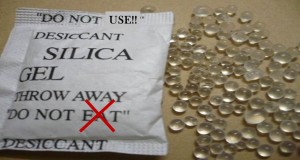I hate to desecrate those supposedly ‘harmless’ desiccant packs that are found in an increasing number of packages, but there is a much more benign alternative! Allow me to explain…
Desiccants are materials used to prevent spoilage, mold, mildew, odors, corrosion and other damage caused by moisture, including something called ‘pop-corning’ which can afflict semiconductors if they come into contact with a bit to much humidity. The main quality of interest in desiccants is that they are ‘hygroscopic’ meaning that they attract and retain water either through adsorption or absorption. High surface area and pore volume are generally what allows for good hygroscopic properties, but ionic compounds come into play as well.
Various materials are used as desiccants but the most popular is silica gel, the (mostly) colorless, odorless micro-beads that come in little (and big) packets that are stuffed into everything from food to shoes to electronics. Silica gel is made from sodium silicate which is made from quartz sand which goes through an awful lot of processing i.e. washing, desliming (who knew that was a word!), scrubbing, flotation, acid leaching not to mention transportation. Translation: silica gel comes with a high carbon footprint not to mention a high likelihood of lots of other negative environmental impacts to make this so-called ‘harmless’ desiccant which is normally only used once then tossed in the trash. Note: Silica gel is also used in cat litter, pillows and a growing number of other products.
Here, of course, is where I must bring up biochar as a much more eco-friendly, not to mention cheaper alternative! While biochar doesn’t normally have as high a surface area as silica gel does (800 m2/g1), biochars made using high temperatures (e.g. 700C+) can have relatively high surface area (interesting comparative table here). Non-activated high temperature chars can have surface areas in the 450+ m2/g1 range, but my research buddy Charchemides has produced biochar with surface areas >860m2/g1 using various highly secret post-treatments!
Moving on to the money angle, biochar can provide advantages at least when it comes to using them in larger quantities such as when they are used in cargo containers. Some of the large silica gel or clay filled cargo bags or pillows can be rather pricey (case in point here; note that the product is only good for 50 days). Material that is only good for 50 days renders it effectively a one time use product meaning that whoever receives the container with the silica gel bags must pay to get rid of then. It also means the original shipper must keep purchasing new bags for every new shipment. This linear economy really only benefits silica gel manufacturers doesn’t it?
Now imagine a food producer getting ready to ship a container of nicely packaged food, say coffee or cacao. Most food producers such as these have large stockpiles of underutilized organic waste which they can easily carbonize into biochar. In lieu of having to purchase countless single use bags of high carbon footprint desiccants for every shipment, they could generate their very own bio-upgradable desiccants in the form of biochar. This not only reduces their costs but it reduces their organic waste stockpiles and very likely improves their own environmental impact on the local environment! When the biochar arrives at the purchaser of these goods, they can either use or sell the biochar. Worst case scenario is that if it ends up in a landfill, it will continue to do good things as I’ve already blogged about previously here. Doesn’t this type of closed-loop scenario make a lot more sense all around?
Yes more research is needed to understand which biochars would perform best in this capacity, but with a few humidity indicator strips/cards, you can do this sort of research at home! Use biochar in your basement, garage, closets, tool box, storage container or anywhere else where humidity might do some damage.


